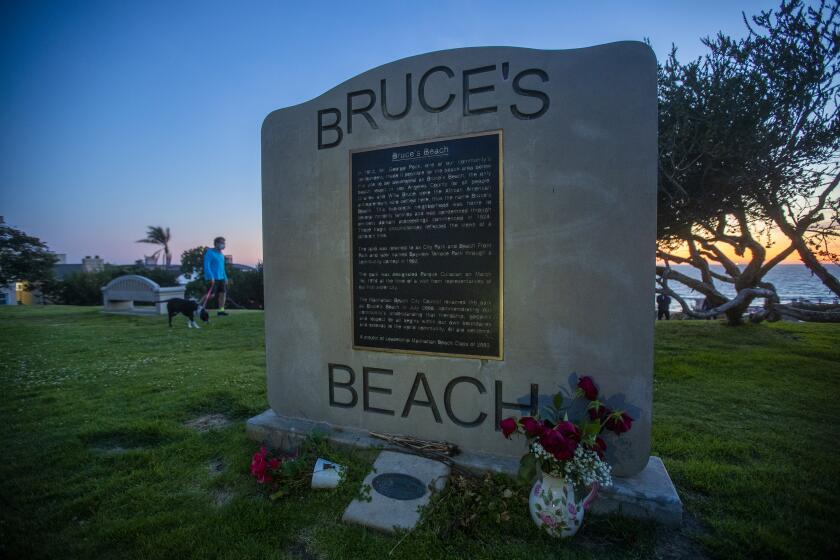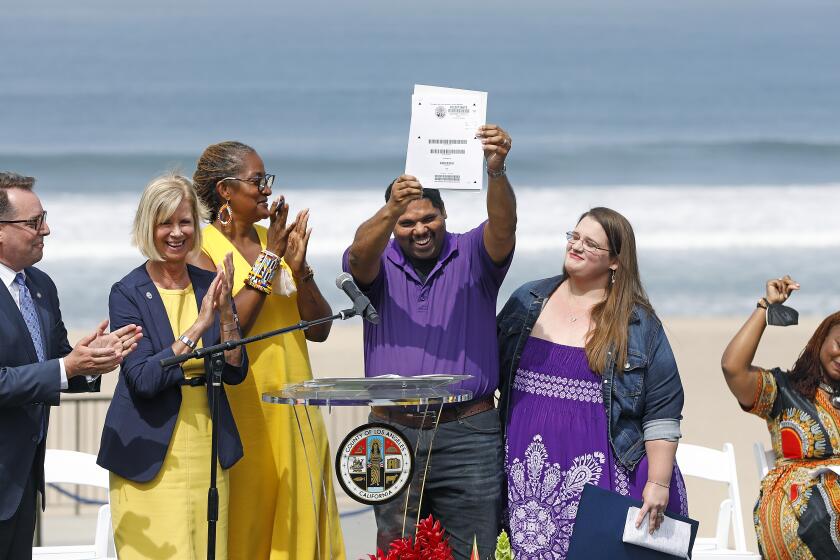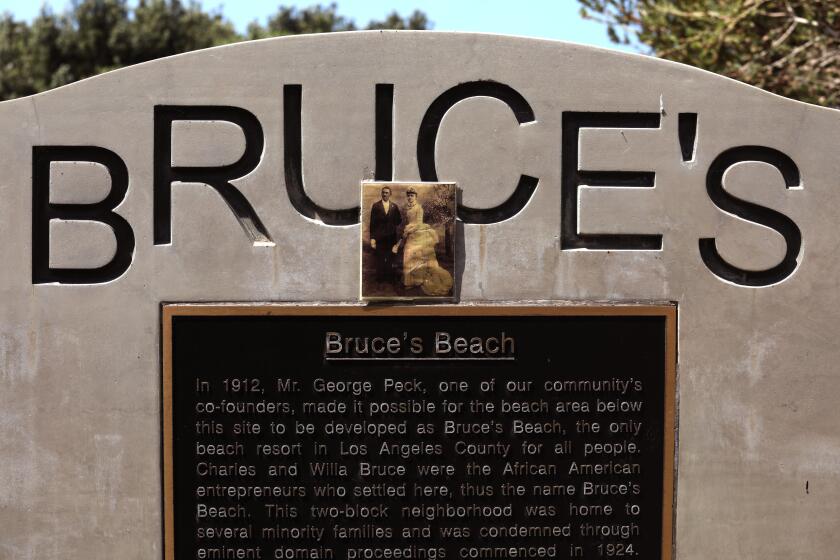Manhattan Beach mayor apologizes to Bruce’s Beach families, unveils new city monument
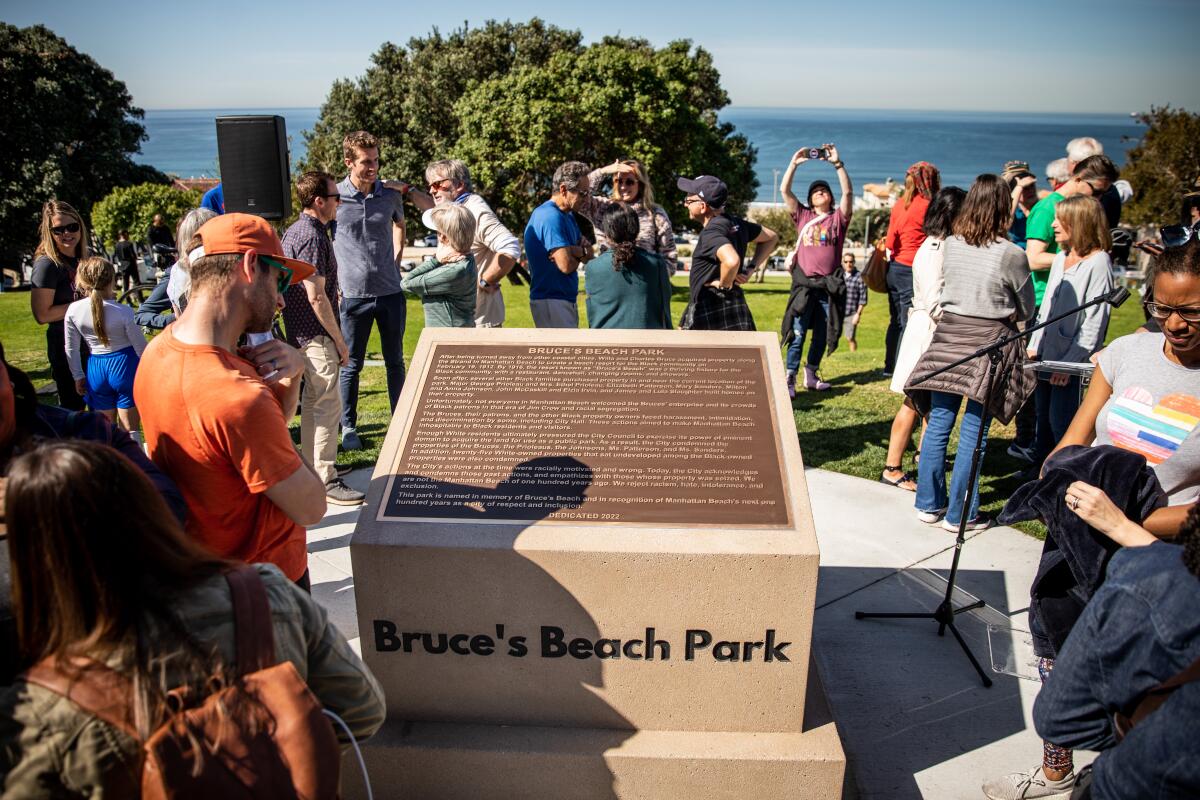
- Share via
After nearly three years of controversy and intense debate, Manhattan Beach on Saturday held a ceremony of its own to acknowledge its racist history at Bruce’s Beach — and to mark what city leaders are calling a new chapter of healing.
More than 100 residents, city staff and government officials gathered to reflect on the fact that the city once ran an entire community of Black beachgoers out of town. Standing before a new monument that spelled out this historical injustice, Mayor Steve Napolitano asked the crowd to join him in a moment of silence.
“It has been a long road — too long — to get here,” said Napolitano, who personally apologized to all the Black families whose properties had been seized by the city a century ago — and who called on the rest of the City Council to do the same. “We’re here today to unveil a new plaque, to reconcile our history, confront some uncomfortable truths, and recognize how far we’ve come — while acknowledging how far we still need to go.”
While Los Angeles County led the unprecedented charge on returning the county-owned portions of the land back to the Bruce family, the local response on what to do with the rest of the land — which had been turned into a park overlooking the sea — has been subject to immense criticism.
Much of the city’s efforts have focused on how to replace a commemorative plaque that had glossed over how and why the land had been taken. City leaders have also dedicated $350,000 for a commemorative art installation that will be the biggest art project ever commissioned in Manhattan Beach.
But deliberations over what the new plaque should say have been charged. Critics say the new text still whitewashes the history of Bruce’s Beach, and many questioned whether creating a new monument actually amounts to justice.
“This feels like far too little, far too late,” said George Fatheree, a prominent real estate transaction lawyer who represented the Bruce family pro bono.
“Where was the city three years ago when the county started the process of returning the land to the Bruce family? What about the property taken from the other Black families which is still owned by the city of Manhattan Beach?” he said. “This feels like a performative gesture rather than an earnest attempt at restitution and reconciliation.”
Manhattan Beach won’t apologize for running Black property owners out of town 100 years ago, but a county official seeks to make restitution.
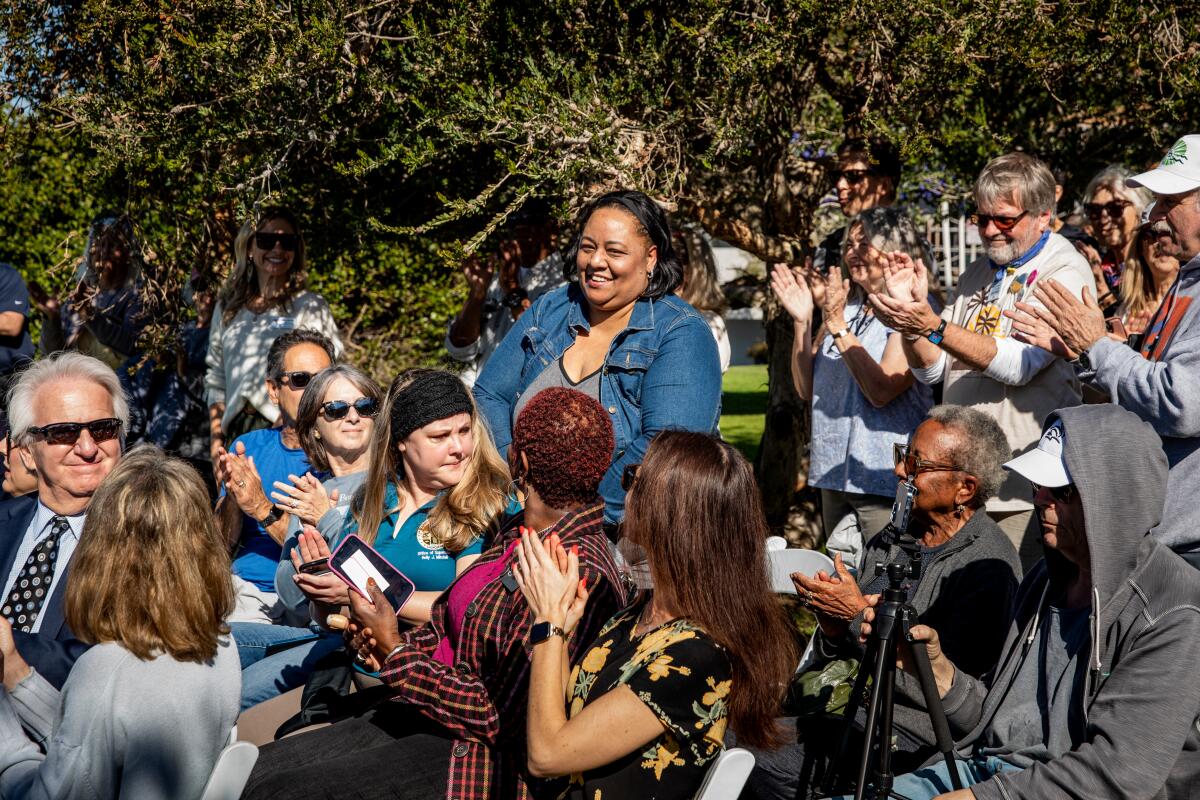
The history of Bruce’s Beach resurfaced in 2020, when a call for justice prompted city, county and state officials to take a closer look at what occurred there.
Charles and Willa Bruce had made their way to California in 1912, years after white developers claimed the ancestral homelands of the Tongva people and established what is known today as Manhattan Beach.
Willa purchased two lots right by the sand and ran a popular lodge that provided a rare welcome to Black beachgoers. A few more Black families, drawn to this new neighborhood that became known as Bruce’s Beach, bought and built their own cottages by the sea.
But white neighbors resented the growing popularity of Bruce’s Beach, and the Ku Klux Klan and local real estate agents purportedly plotted to harass them. City officials in 1924 ultimately condemned the entire neighborhood and seized the Black-owned properties, as well as 25 empty lots owned by white speculators. They said there was an urgent need for a public park.
But the properties sat empty for decades. The two Bruce parcels were transferred to the state in 1948, then to the county in 1995. The other lots, still owned by the city of Manhattan Beach, were eventually turned into a park.
Recent actions taken by the county and city in response to this history have been a tale of two reckonings: County leaders promptly sought ways to return the county-owned parcels to the Bruce family. (That transaction, valued at $20 million, was completed last summer in a heartfelt ceremony.)
In a heartfelt ceremony, Los Angeles County completed the historic land return of Bruce’s Beach by handing the deed to its rightful Black heirs.
The response from Manhattan Beach city leaders, meanwhile, has led to one controversy after another. A painstaking history report was completed. An apology drafted. But some expressed concern that an apology would expose the city to potential lawsuits.
While many still take issue with the city refusing to formally apologize to the Bruce family, the mayor’s personal apology drew big cheers Saturday. The new plaque also notes that “The City’s action at the time was racially motivated and wrong. Today, the City acknowledges and condemns those past actions, and empathizes with those whose property was seized.”
The sign also names the other Black families whose properties had been condemned: the Prioleaus, the Johnsons, Ms. Patterson and Ms. Sanders.
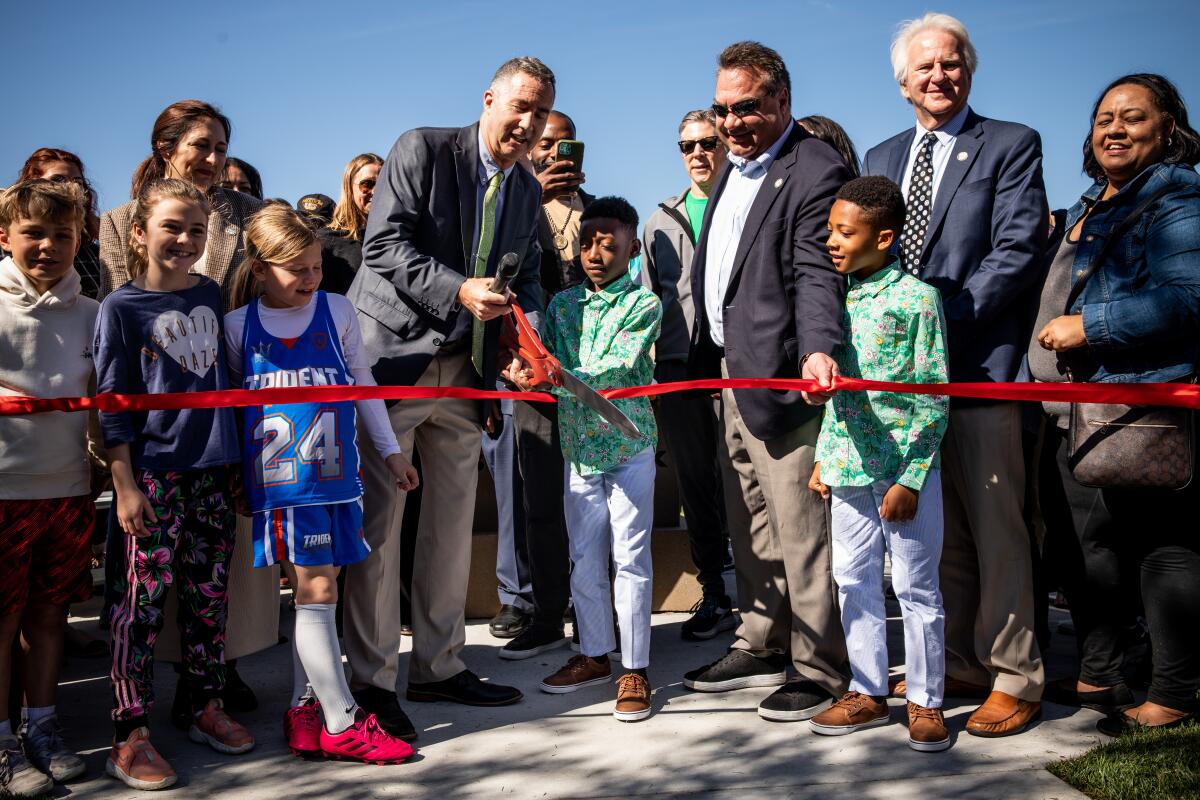
Alison Rose Jefferson, a historian who documented the story of Bruce’s Beach in her book “Living the California Dream: African American Leisure Sites during the Jim Crow Era,” said the city’s new memorial does illustrate a better understanding of the history — it at least describes the property seizures in clear detail — but there are still a number of inaccuracies in the text.
It also erases a key part of the story: Bruce’s Beach should not be remembered only as a place with a painful past — it is also a place where Black entrepreneurship thrived and where Black joy could exist, Jefferson said. Bruce’s Beach was also a community — a community that needs to be remembered and ultimately rebuilt.
A new monument doesn’t change the fact that Manhattan Beach’s population today remains less than 1% Black, she said. A monument doesn’t change the fact that access to the beach still feels unobtainable to many inland communities of color.
“That is a legacy of chasing the Bruces and the other families out of Manhattan Beach in the 1920s,” Jefferson said. “What is Manhattan Beach going to do to resolve that? … What is the city going to do to encourage more folks to use the beach, to be able to live in the community?”
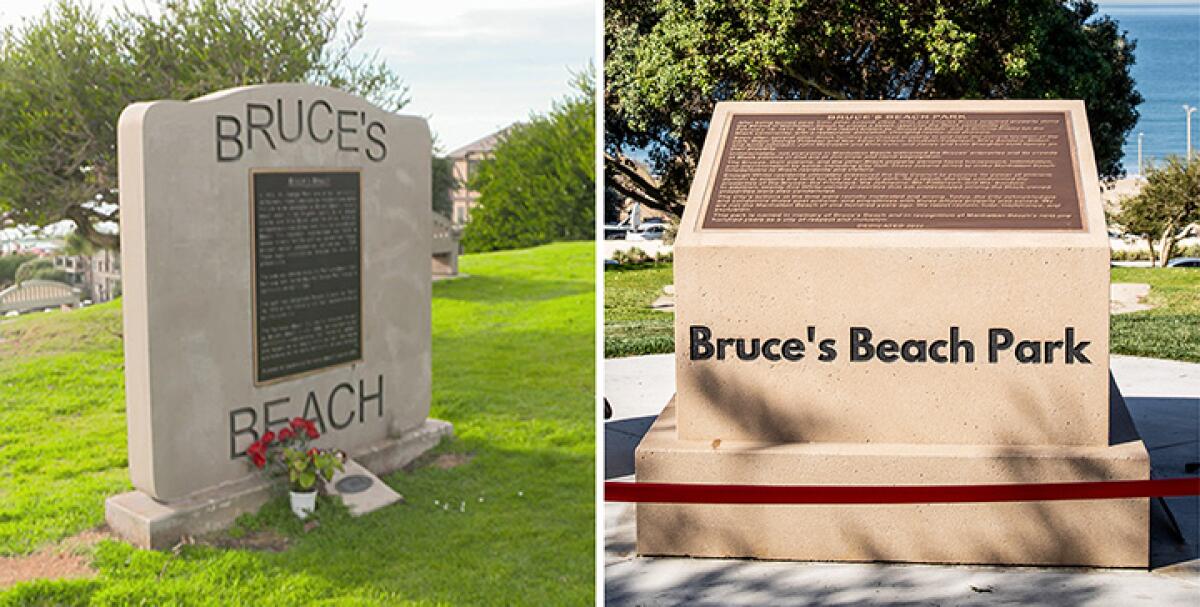
Kavon Ward, who started the grassroots movement Justice for Bruce’s Beach, said that instead of spending $350,000 on an art installation, the city could have considered new affordable housing policies. The city could have made the Bruce family feel welcome — perhaps even helped them navigate the zoning restrictions on their oceanfront property, rather than just letting it sit there as a public-use-only parcel. (Moving to Manhattan Beach was untenable for the Bruces, who decided last month to sell the property back to the county.)
“Everything as it relates to housing, education, policing — everything today says this is the same Manhattan Beach that it was 100 years ago,” said Ward, who is now helping five other Black families in California with stories similar to that of the Bruces. “Manhattan Beach still has a debt to pay to all of the Black families forced out of that community and to all of the Black people they continue to systematically prevent from taking up space in that community.”
County officials say the Bruce family has agreed to sell the Bruce’s Beach property in Manhattan Beach back to Los Angeles County for nearly $20 million.
Mitch Ward, who had sought to bring the history of Bruce’s Beach to light in 2006 after he became the city’s first Black elected official, said he found this passage in the sign particularly offensive: “In addition, twenty-five White-owned properties that sat undeveloped among the Black-owned properties were also condemned.”
“The Bruces were targeted in a racist manner by our government, and by racist citizens, and to equate them in any fashion — especially on a historical marker — with someone who simply had a deed, a speculative deed, who lived all the way across the United States … that is a gross misrepresentation of history,” he said.
But Ward (no relation to Kavon Ward) acknowledged that Bruce’s Beach has in some ways transcended local politics. Visitors across the county now come to the park to reflect and pay homage to what Ward calls a “national treasure for Black people.”
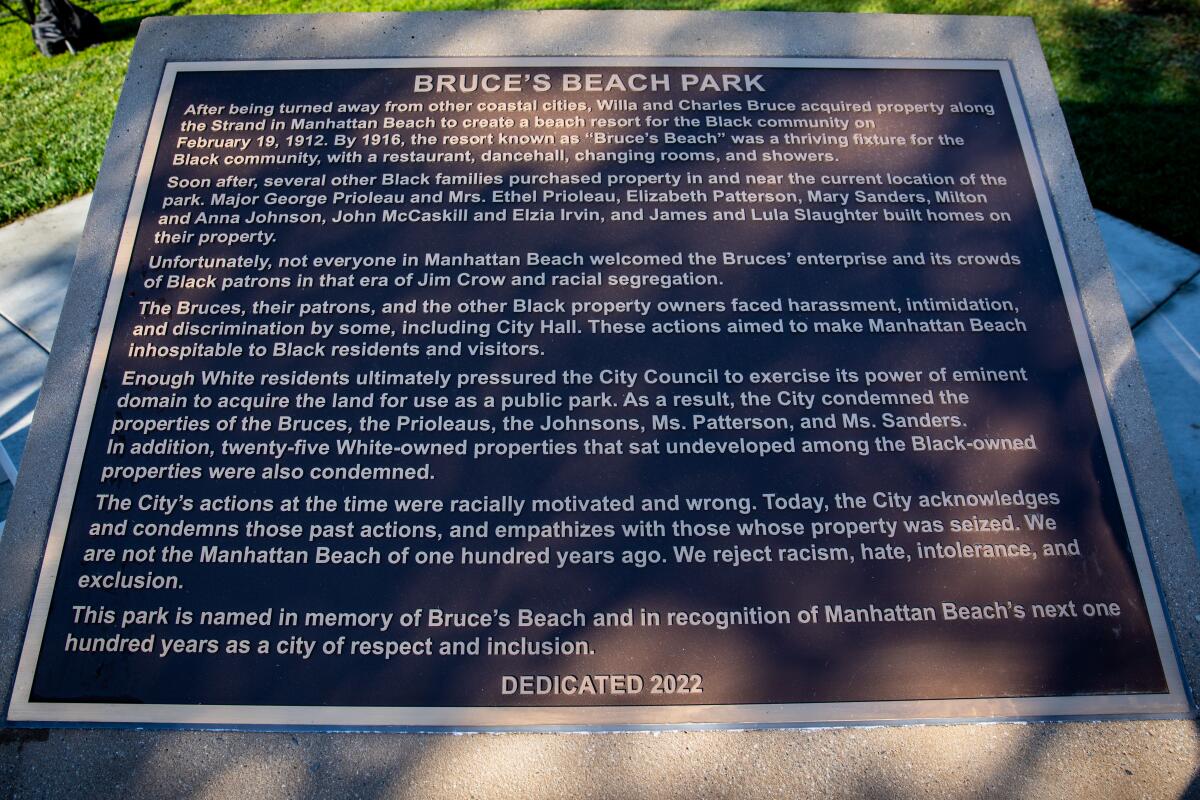
Reaching even this inflection point has been far from easy for Manhattan Beach, but many in town hoped Saturday’s gathering meant the community had finally found a way to move forward. A page dedicated to the history of Bruce’s Beach now lives permanently on the city’s website, and the city is in the final weeks of accepting proposals for the art installation, which it said should “evoke a sense of peace, healing, and community, and offer an educational opportunity for visitors to learn about the history of this area.”
“It can’t stop there,” said Susan Bales, a longtime resident who said the mayor’s apology was overdue. “The city needs to also look at other aspects of the city’s infrastructure that continue to make this a predominantly white town.”
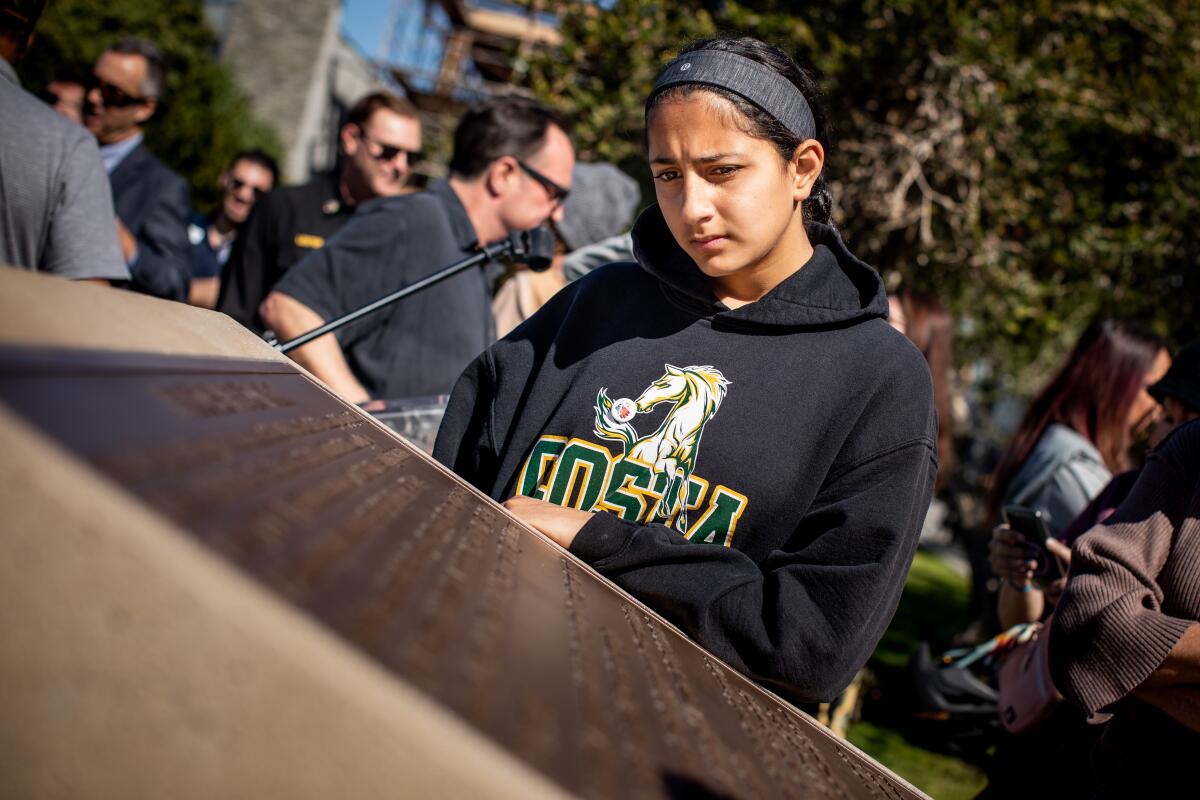
Reviving this history has also led to meaningful discoveries. Gina Young, who lives in Glendale, said she did not know her family had any connection to Bruce’s Beach until 2021, when she saw that her great-great-aunt, Elizabeth Patterson, was one of the owners whose property had been seized by Manhattan Beach in the 1920s.
“I felt like I needed to be here to support my family,” said Young, who attended Saturday’s ceremony and appreciated the mayor’s apology. “They went through a lot in the ‘20s and just by me being here is a way to honor that.”
Patricia Bruce-Carter, a distant relative who helped connect many of the pieces for Charles and Willa Bruce’s direct descendants, said that memorializing this space, even if the text remains flawed, is still significant after almost a century of hurt and intentional erasure.
“I feel a sense of pride, knowing that this Black couple, 100 years ago, came to California, followed their dream, and was successful and was thriving,” she said. “It takes much longer than it should … but history is continuing to correct itself, and I am glad to say that I am here to witness it.”
More to Read
Sign up for Essential California
The most important California stories and recommendations in your inbox every morning.
You may occasionally receive promotional content from the Los Angeles Times.
